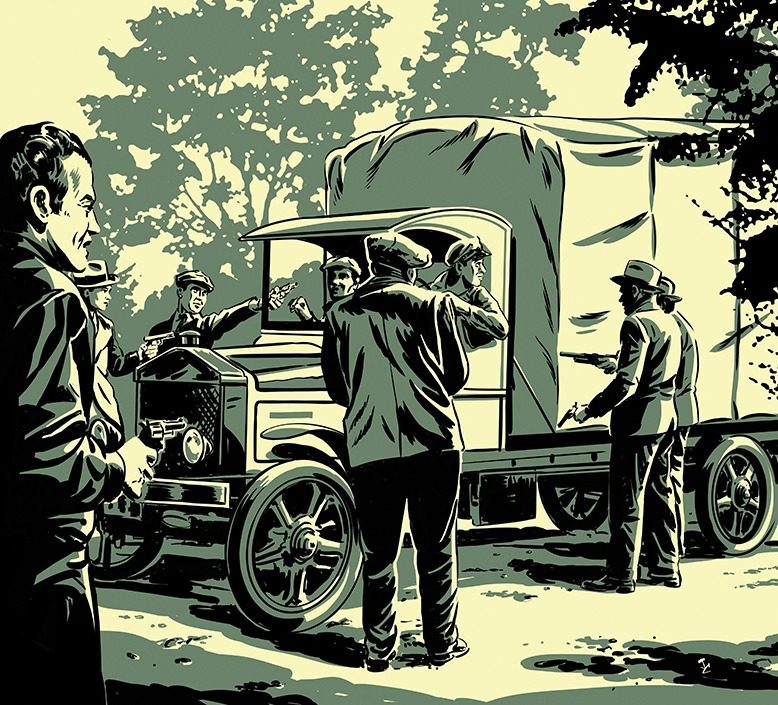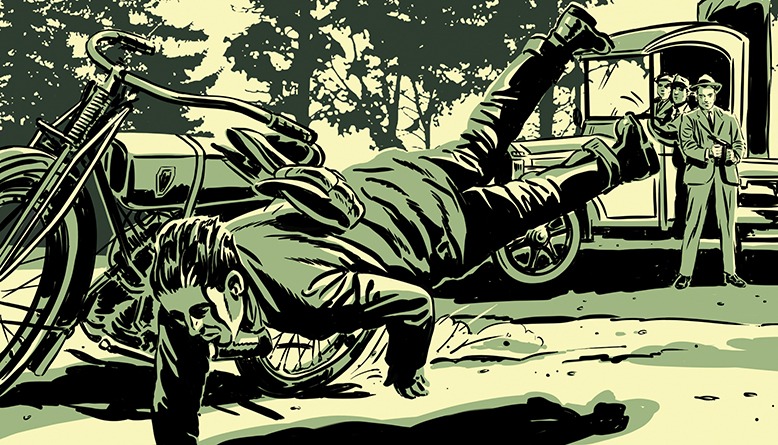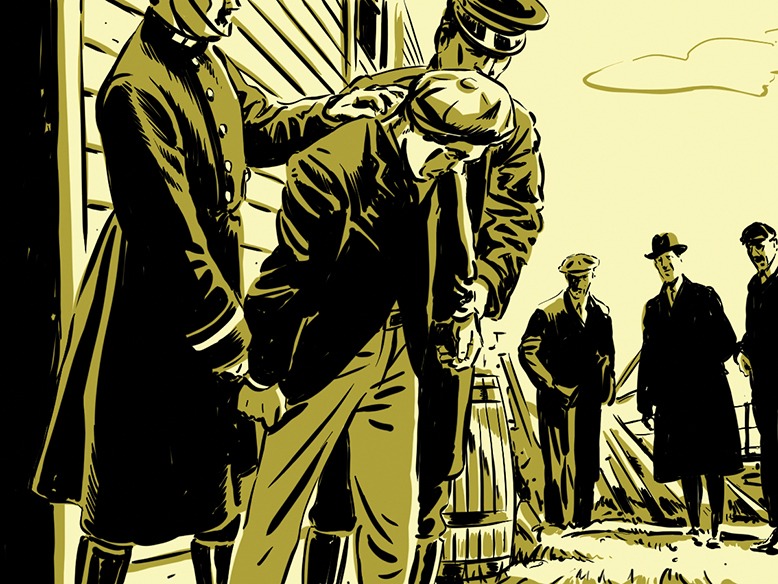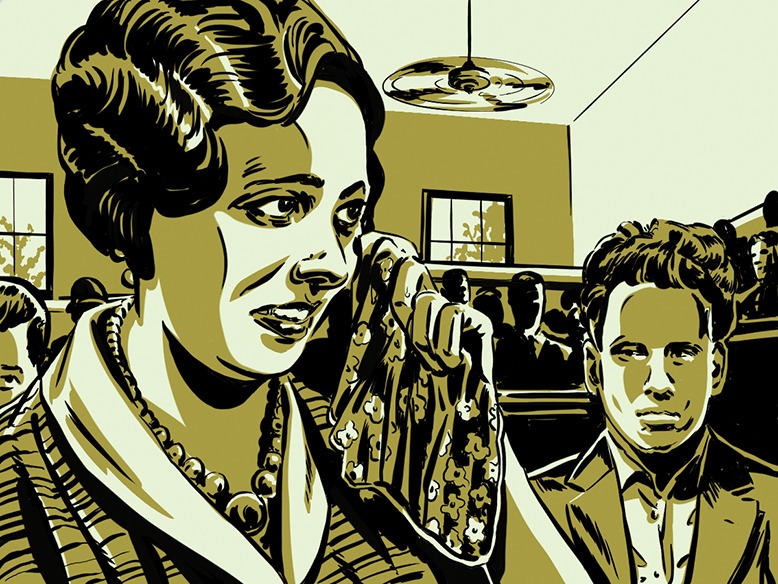
Claude Resh and Charles Maines made their semiweekly delivery of bolts of silk from Newton to Passaic. Traveling along what is now Route 206 at Cranberry Lake in Byram, they saw Albert Koster—a familiar figure whom they regularly passed—working on his motorcycle by the side of the road. Minutes later, as Resh steered the Sussex Print Works truck through an uphill curve at a neck of the woods called Cat Swamp, six masked men rushed from the trees, guns drawn. What followed was one of the most brutal crimes ever in Sussex County—still shocking 100 years later.
In the years following World War I, armed bandits regularly hijacked deliveries as they traversed New Jersey. Stolen items were hawked by vendors in cities across the country, and insurance companies scrambled to recoup losses. Gangs were known to share funds for bail and legal fees.
Wedged into the northwest corner of the state, Sussex County is dense with forests—the perfect setting for a hijacking. In the early part of the 20th century, the area was home to a burgeoning silk industry. The Sussex Print Works, one of numerous silk factories in the county, was known for high-quality products—including four dress silks created for Edith Bolling Galt when she married President Woodrow Wilson in 1915. The factory’s memorable motto: “Our customers are our friends.”
***
Tony Turko, a taxi driver from Easton, Pennsylvania, led his gang to Newton on June 13 to stake out the silk factory. After a night of drinking whiskey to calm their nerves, they woke early and hid in the Cat Swamp woods. Moving out to the road, the bandits surrounded the slow-moving silk truck at gunpoint—three on each side—forcing it to a halt. The gang pulled Resh and Maines out, put guns to their heads, and led them into the woods. “One of the men told me that I had better say my prayers because my time was nearly up,” Maines would later testify.
Koster, having fixed his motorcycle, rode toward his job at a salt and gravel plant in Stanhope. As he passed the silk truck, still parked along the road, he slowed to look at the driver and must have noticed two strange men in the cab.
Turko, suspecting that Koster was a police officer, shot him off the bike. Angelo Carlino, another member of the gang, followed with two more shots. Koster was dead by the time he hit the ground. The hijacking was now a murder.

THE CRIME: Koster was dead by the time he hit the ground. The hijacking was now a murder. Illustration by Jonathan Carlson
Two of the bandits grabbed Koster by his arms and legs and threw him down the Cat Swamp embankment. He landed in a creek, and Turko pushed his face into the mucky bottom. Meanwhile, Resh and Maines, who had witnessed the shooting, struggled for their lives. The bandits smashed each of them on the back of the head with revolvers, bound their hands and feet, and dragged them deep into the swampy woods.
The hijacked truck was well on its way to Pennsylvania, but the nightmare in the woods continued. One bandit fired a wayward shot at Maines, causing a scuffle among the gang. Turko said he only shot at Koster because Koster could have gone for help; another killing, he said, wasn’t necessary. Carlino argued that dead bodies meant no witnesses—and a faster getaway. Turko won the argument. The gang tied their captives to a tree. Turko, quiet, kept checking his watch. Around 2:30, he stole $40 from Maines—the expense money for the trip. “He gave me back $1,” Maines said, “and told me to buy a box of candy for my girl.” Another gang member left Resh with a warning: “Stay here and starve.”
Once the gang was out of sight, Resh kicked himself loose. He gnawed at the ropes that bound Maines’s hands, breaking several teeth in the process. Bloodied and exhausted, Resh finally broke his partner’s bindings, and both men were free. They stumbled through the woods until they reached a farmhouse.
The county sheriff led a search party into the woods, where they found Koster’s body. The manhunt began for the bandits, and the truck, a two-ton, yellow-and-green Pierce Arrow, license plate 28422 NJ. “Sussex Print Works, Newton, N.J.” was printed in gold on the doors. The truck carried $20,000 worth of stolen goods.
The next day, a man spotted the abandoned truck on a country road near Kintnersville, Pennsylvania. The stolen goods were gone.
The gang soon met its match in Herbert C. Irons. Born in 1890 in Brooklyn, Irons served as a police officer in the Panama Canal Zone before joining the Pennsylvania State Police. He attracted the attention of officials in Franklin, a booming mining town full of recent immigrants whose arguments about World War I allegiances bled into street fights. When a skeleton was found in one of the mine shafts—and nobody would talk—a local mining company decided it was time to create a police force of one: Herbert C. Irons.
The mayor of Franklin recruited Irons, describing him to the press as a “big, muscular chap.” Other reports said Irons “did not know what it was to be afraid.” Decked in an “enormous greatcoat, leather puttees and black boots,” Irons rode a horse around town, bringing the aura of the Wild West. He became Franklin’s chief of police on October 1, 1915, a position he held for 42 years.
***
After hunting the gang for months, Irons located the ringleader’s wife and followed her to a secluded farm near Easton. He and other officers surrounded the property and arrested Turko in his room. Irons then searched the barn, poking piles of hay with a pitchfork. Carlino, the bandit who wanted to kill Resh and Maines, fled. As he ran, Carlino shot Rush Steblin, an Easton officer. Irons returned fire and landed four shots, wounding Carlino.

THE ARREST: Officers surrounded the property and arrested Turko. Illustration by Jonathan Carlson
After some weeks in the hospital and the Northampton County Jail, Carlino was transferred along with James Montana to Newton, where both men were given a fresh shave—and positively identified by Resh and Maines. They were the only bandits who had removed their masks. Several men were charged, but two turned against the group: Ottario Sparacio, who drove the men to Newton the night before, and John Merlo, who was paid $60 to haul away the silk.
Turko’s murder trial captivated northwest New Jersey. Locals demanded justice, compelling officials to call in 10 troopers from the recently formed State Police to guard the county jail and courthouse. Attorneys argued that Turko wasn’t able to get a fair trial because of anti-immigrant sentiment. Turko (born Antonio Laturco) and his crew were Italian nationals, and the trial was unfolding in the wake of the Wall Street bombing by an Italian anarchist group. Irons received death threats.
Meanwhile, in the courtroom, Koster’s widow, Anna Caroline Koster, wept when confronted with her husband’s alleged murderer. The community held fundraisers to help the widow, who had been left to raise her daughter alone. During the trial, Turko “stared her in the face without a trace of emotion.”

THE COURTROOM: Koster’s widow wept when facing the accused. Illustration by Jonathan Carlson
Turko’s previous heists bankrolled the formidable Paterson-based defense team of Ward & McGinnis, but the prosecution was tough, too. Before the packed courtroom, they described how Turko’s gang “terrorized citizens, towns and the entire countryside” in Pennsylvania and New Jersey. A gang member testified that Turko “shot Koster down in cold blood.”
Prior to his ultimate arrest, Turko had been nabbed in New York City as he attempted to flee to Italy without a passport. At that time, he escaped “the patrol wagon while on his way to the police station”—and headed to the Pennsylvania hideout.
Unbeknownst to his defense team, Turko confessed to the crime while in jail during an impromptu conversation with Eugene Scrivani, an officer of the famed Italian Squad of the New York City police department—a group of Italian-American officers who investigated crimes within the immigrant community. War-tested by their confrontations with the Mafia and the notorious Black Hand assassins, the Italian Squad was well trained and persuasive.
Turko must have felt comfortable speaking with the Italian officer. Scrivani testified that Turko had said he was sorry for the murder—and would give his remaining money to the dead man’s wife if he could return to Italy. As the trial neared its conclusion, Turko offered the county prosecutor a $10,000 bribe if they “would turn him loose.”
[RELATED: Book Revisits Infamous NJ Case of Murder for Hire]
Turko was found guilty of murder on January 24, 1922. He turned to Irons in the courtroom gallery and glared: “Now I hope you’re satisfied.” Word came that Turko’s friends planned to attack the jail to free him. The dozens of officers on security detail deterred any attacks, but tension remained high at Turko’s sentencing. Normally silent and sullen, Turko interrupted the judge to say, “I am innocent.” He was sentenced to death by the electric chair. Afterward, Irons accompanied a shackled Turko on the ride to Trenton State Prison.
Turko’s lawyers noted that, when the jury announced the guilty verdict, they failed to specify the degree of murder. His lawyers appealed to the New Jersey Supreme Court, saying Turko deserved a new trial on that technicality.
To the dismay of local residents, Turko was granted a new day in court. This time, he was represented by William A. Dolan, a former Sussex County prosecutor and later a state senator, and Egbert Rosencrans of Blairstown—who later defended Bruno Richard Hauptmann in the Lindbergh kidnapping case. A press report described Turko as looking paler this time. His wife, clad in black, waited in a downstairs hall rather than the courtroom.
Turko was again sentenced to the electric chair—perhaps the only person ever to have the dubious distinction of being condemned twice. This time, there was no reprieve. Turko and Carlino were executed at the state prison on January 29, 1924. Five other gang members, some of whom had testified for the state, were given various sentences for their roles in the hijacking.
***
That fateful morning in 1921 seemed to curse those connected. Rush Steblin, the officer injured in the farmland firefight, was shot and killed a year later while trying to stop a robbery. In 1927, Claude Resh died at age 48—from lingering injuries he had sustained at Cat Swamp.
Charles Maines, on the other hand, lived until around 1950. He and his wife raised their daughter, Imogene. Years later, a family descendant posted a photo on the ancestry.com website of a crumpled old dollar and a note from Imogene. According to the note, the dollar bill was the one given to Maines by one of the bandits to “buy a box of candy” for his girl.
The Cat Swamp hijacking and murder was the last such crime in the Sussex County area, as insurance companies and state police started to patrol the roads to deter would-be hijackers. But the story doesn’t end there.
A few months after the execution of Turko and Carlino, three men were arrested for a daylight robbery of a silk truck in Hoboken. The driver and his helper worked for the same Sussex Print Works and claimed that six armed men jumped out of a limo and robbed them. The helper soon confessed that the incident was a hoax; he and the driver had conspired to steal the goods. The driver’s name: Charles Resh, a cousin of Claude Resh.
Nick Ripatrazone has written for Rolling Stone, GQ and The Atlantic. His next book, Wild Belief: Poets and Prophets in the Wilderness, is due in May from Broadleaf Books.
